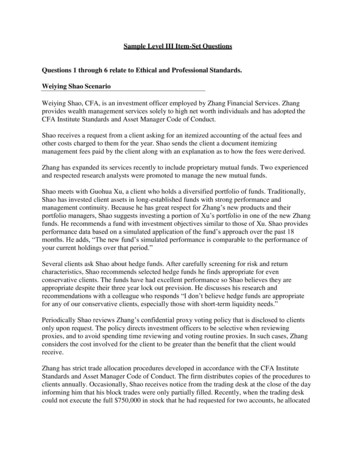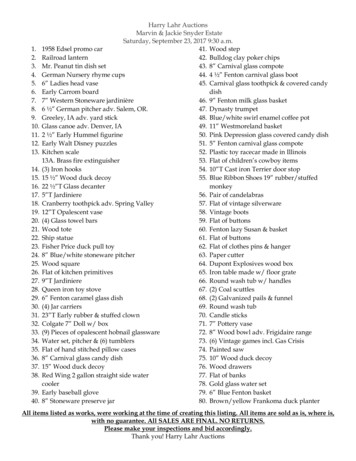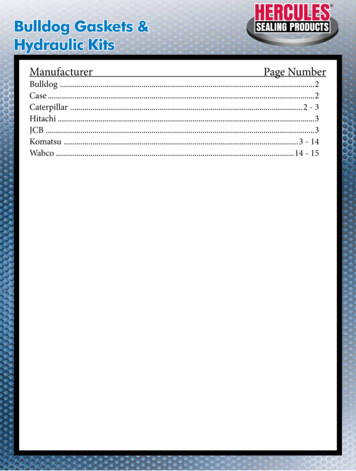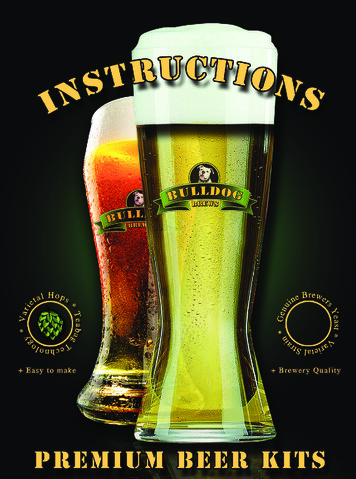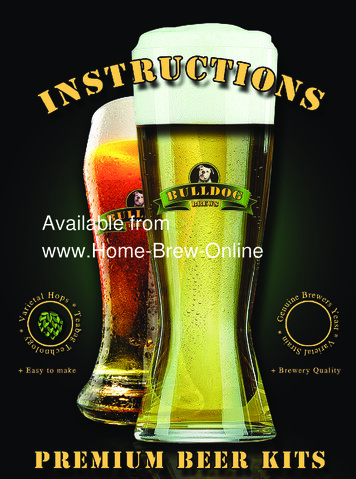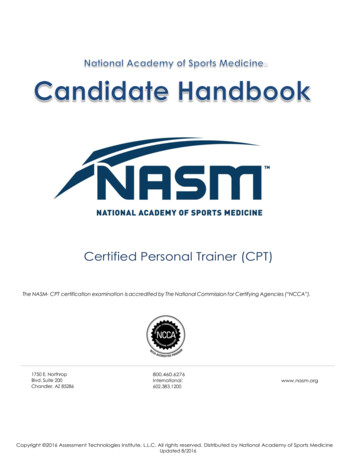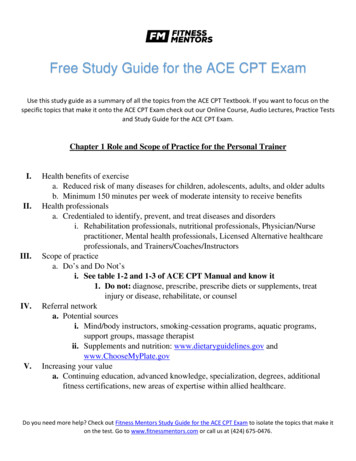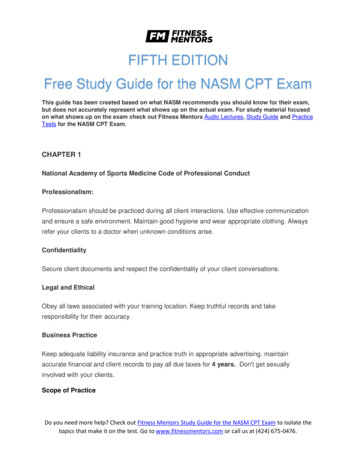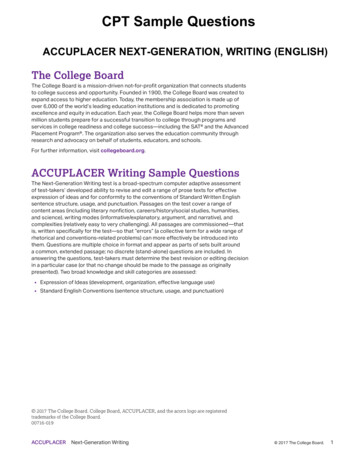
Transcription
CPT Sample QuestionsACCUPLACER NEXT-GENERATION, WRITING (ENGLISH)The College BoardThe College Board is a mission-driven not-for-profit organization that connects studentsto college success and opportunity. Founded in 1900, the College Board was created toexpand access to higher education. Today, the membership association is made up ofover 6,000 of the world’s leading education institutions and is dedicated to promotingexcellence and equity in education. Each year, the College Board helps more than sevenmillion students prepare for a successful transition to college through programs andservices in college readiness and college success—including the SAT and the AdvancedPlacement Program . The organization also serves the education community throughresearch and advocacy on behalf of students, educators, and schools.For further information, visit collegeboard.org.ACCUPLACER Writing Sample QuestionsThe Next-Generation Writing test is a broad-spectrum computer adaptive assessmentof test-takers’ developed ability to revise and edit a range of prose texts for effectiveexpression of ideas and for conformity to the conventions of Standard Written Englishsentence structure, usage, and punctuation. Passages on the test cover a range ofcontent areas (including literary nonfiction, careers/history/social studies, humanities,and science), writing modes (informative/explanatory, argument, and narrative), andcomplexities (relatively easy to very challenging). All passages are commissioned—thatis, written specifically for the test—so that “errors” (a collective term for a wide range ofrhetorical and conventions-related problems) can more effectively be introduced intothem. Questions are multiple choice in format and appear as parts of sets built arounda common, extended passage; no discrete (stand-alone) questions are included. Inanswering the questions, test-takers must determine the best revision or editing decisionin a particular case (or that no change should be made to the passage as originallypresented). Two broad knowledge and skill categories are assessed: Expression of Ideas (development, organization, effective language use) Standard English Conventions (sentence structure, usage, and punctuation) 2017 The College Board. College Board, ACCUPLACER, and the acorn logo are registeredtrademarks of the College Board.00716-019ACCUPLACERNext-Generation Writing 2017 The College Board.1
Sample Questions2.Read the following early draf of an essay and thenchoose the best answer to the question or the bestcompletion of the statement.(1) Te prevalence of nectarines in US supermarketstoday is directly related to the company startedby two unrelated men who shared a last name, aninventive bent, and a drive to succeed. (2) Movingfrom Korea to the United States in 1914, Ho“Charles” Kim founded the Kim Brothers truckingcompany in California in 1921 with his friendHarry Kim. (3) Much of the freight their truckscarried in the early years were fruit grown in theSan Joaquin valley. (4) Kim Brothers soon expandedto include nurseries, orchards, and fruit-packingsheds. (5) Eventually the operation became a majoremployer, providing year-round jobs for about twohundred people and up to four hundred part-timejobs during harvest season coming afer growingseason.(6) Kim Brothers succeeded even in the faceof the Great Depression of the 1920s and 30sbecause the company produced and sold the frstcommercially viable nectarines. (7) Te nectarineis a hybrid fruit. (8) It combines peach and plum,with the taste and texture of the former and thesmooth skin of the latter. (9) With the help of astaf horticulturalist, Kim Brothers developedand patented the “fuzzless peach” known as theSun Grand nectarine. (10) Tough not the frstnectarine—the fruit had existed in China for twomillennia; the Sun Grand was unique in beinghardy enough to ship great distances.(11) By the 1960s, Kim Brothers included morethan fve hundred acres of farmland and grossedmore than 1 million annually. (12) Charles andHarry Kim were eventually recognized as the frstmillionaires of Korean descent. (13) Tey werealso known for giving back to their community.(14) Charles was also instrumental in helping tocreate Los Angeles’s Koreatown (home today tomore Koreans than any place other than North andSouth Korea).1.Which is the best version of the underlined portion ofsentence 3 (reproduced below)?Much of the freight their trucks carried in the early yearswere fruit grown in the San Joaquin valley.A.B.C.D.(as it is now)have beenarewasACCUPLACERNext-Generation WritingWhich is the best decision regarding the underlinedportion of sentence 5 (reproduced below)?Eventually the operation became a major employer,providing year-round jobs for about two hundred peopleand up to four hundred part-time jobs during harvestseason coming afer growing season.A.B.C.D.3.Leave it as it is nowRevise it to “when the crops were ready to pick.”Revise it to “afer the produce had ripened.”DELETE it and end the sentence with a periodWhich is the most logical placement for sentence 7(reproduced below)?Te nectarine is a hybrid fruit.A.B.C.D.4.Where it is nowAfer sentence 3Afer sentence 10Afer sentence 11Which is the best version of the underlined portion ofsentence 10 (reproduced below)?Tough not the frst nectarine—the fruit had existed inChina for two millennia; the Sun Grand was unique inbeing hardy enough to ship great distances.A.B.C.D.5.(as it is now)millennia. Temillennia—themillennia) theSentence 13 is reproduced below.Tey were also known for giving back to their community.Te writer is considering adding the following text atthe end of the sentence.by building churches, funding scholarships, andestablishing the Korean Association of SouthernCaliforniaShould the writer make this addition there?A. Yes, because it elaborates on the claim made at thebeginning of the sentence.B. Yes, because it establishes the historical period inwhich Kim Brothers operated.C. No, because it introduces details that are irrelevantto the paragraph’s focus on nectarines.D. No, because it fails to explain whether theinstitutions that the Kims established still existtoday. 2017 The College Board.2
(1) In the Sahara, near the border of Moroccoand Algeria, a new species of spider, Cebrennusrechenbergi, has been found. (2) Tese spiders don’tsimply scurry across the sand on their many legs, liketumbling gymnasts, they propel themselves forward(or backward) in a series of quick fips. (3) Tey dothis, however, only to elude predators, not to chaseprey. (4) A human is thus unlikely ever to see thesearachnids fipping toward him or her, only away.(5) A spider of this species was discovered in theErg Chebbi. (6) It is a sandy desert in southeasternMorocco. (7) A German robotics researcher whomakes yearly treks to the region to study howdesert creatures thrive in that climate caught oneof the spiders and brought it back to his caravan.(8) Te next morning, he was amazed to see thecreature try to escape by fipping itself quicklyaway. (9) Te researcher turned the spider overto an arachnid specialist for identifcation.(10) Ultimately, the spider was determined to be amember of a previously unknown species.(11) C. rechenbergi are “huntsman spiders”—skilledpredators—found only in the Erg Chebbi. (12) Teyare nocturnal creatures; during the day, they restin tubes of silken thread they weave into the sand.(13) Agile and athletic, C. rechenbergi rear up ontheir back legs and lash out when attacked—or itsomersaults away, rolling like tumbleweed.(14) Few spiders propel themselves as C. rechenbergido, and none do so as comprehensively. (15) Goldenrolling spiders of Namibia, for instance, can tumble,but they do so only using gravity to roll downhill.(16) C. rechenbergi, by contrast, elude predators byrolling uphill, downhill, or on fat ground. (17) Teirreproductive organs distinguish them from otherCebrennus spiders. (18) While these spiders runonly 3.3 feet per second, they can tumble at 6.6 feetper second. (19) Even if this speedy escape methodproves efective, however, it can be costly: tumblingaway too many times a day will ultimately exhaustthe spiders and lead to their demise.6.7.Which choice most efectively combines sentences 5 and6 (reproduced below) at the underlined portion?A spider of this species was discovered in the Erg Chebbi.It is a sandy desert in southeastern Morocco.A.B.C.D.8.Chebbi,Chebbi—this beingChebbi, and the Erg Chebbi isChebbi, the Erg Chebbi beingIn context, which is the best version of the underlinedportion of sentence 10 (reproduced below)?Ultimately, the spider was determined to be a member ofa previously unknown species.A.B.C.D.9.(As it is now)For example,Nevertheless,At the same time,Which is the best version of the underlined portion ofsentence 13 (reproduced below)?Agile and athletic, C. rechenbergi rear up on their backlegs and lash out when attacked—or it somersaults away,rolling like tumbleweed.A.B.C.D.(as it is now)it will somersaultthey somersaultthey were somersaulting10. Which sentence blurs the focus of the last paragraphand should therefore be deleted?A. Sentence 14B. Sentence 15C. Sentence 16D. Sentence 17Which is the best version of the underlined portion ofsentence 2 (reproduced below)?Tese spiders don’t simply scurry across the sand on theirmany legs, like tumbling gymnasts, they propel themselvesforward (or backward) in a series of quick fips.A.B.C.D.(as it is now)legs like tumbling gymnasts;legs; like tumbling gymnasts,legs like tumbling gymnasts,ACCUPLACERNext-Generation Writing 2017 The College Board.3
(1) Of her poetry, Lucille Clifon once said, “I writeout of what I know and understand or what I wonderabout.” (2) From her very frst volume, Good Times,she gave tribute to the people she knew best: thosewho had grown up in blue-collar neighborhoodswhere children pondered whether Daddy could paythe rent and Mama could aford to make bread butwhere “good times” prevailed when they could.(3) Family, injustice, being African American andfemale were Clifon’s enduring themes. (4) Clifonwas born in Depew, New York, in 1936. (5) In hercollection Quilting, the speaker in the title poemdraws a parallel between a woman teaching herdaughter how to quilt and the transformativepowers of alchemy. (6) “Remember / this will keepus warm,” she says to the girl. (7) Te speakerwonders, however, whether the skills of keepingwarm will one day be forgotten and people will losesight of lessons their ancestors had taught: “do thedaughters’ daughters quilt?” she asks; “do the worldscontinue spinning away from each other forever?”(8) Concerned about those who are frequentlyexcluded from the historical record, Clifon saidthat through poetry “I ofer my presence for peoplewho have not been able to speak until they are ableto speak for themselves.” (9) Her poems ofen borewitness to what she called “the bond of live thingseverywhere,” a bond she evoked through seeminglysimple but precisely chosen words.(10) Clifon’s powerful and innovative poemshave been widely recognized and appreciated. (11)Poet Remica Bingham called Clifon a “masterof economy and minimalism.” (12) Of Clifon’sambitious lines, poet Kevin Young said, “Tereis a kind of quietude in that lowercase, but alsoa boldness of speech” that achieves a “powerfulintimacy.” (13) One of her former students, poetElisabeth Whitehead, recalls fondly Clifon’s collegeclassroom as a place of quiet where poetry was lovedand celebrated. (14) A fellow student hosted dinnerfor their fnal class, and before everyone had lef thatevening, Clifon had them gather and join hands.(15) “Ten we went around the circle,” Whiteheadrecounts, “sharing an idea or a quote or passagefrom a poem in our last moments together.”12. Which sentence blurs the focus of the second paragraphand should therefore be deleted?A.B.C.D.Sentence 4Sentence 5Sentence 6Sentence 713. Which is the best version of the underlined portion ofsentence 9 (reproduced below)?Her poems ofen bore witness to what she called “thebond of live things everywhere,” a bond she evokedthrough seemingly simple but precisely chosen words.A.B.C.D.(as it is now)called:called—called,14. Which version of the underlined portion of sentence10 (reproduced below) provides the most efectiveintroduction to the last paragraph?Clifon’s powerful and innovative poems have beenwidely recognized and appreciated.A.B.C.D.(as it is now)passion for teaching others about poetry hasdesire to use poetry to speak for the powerless hasmany gifs as a writer and teacher have15. In sentence 12 (reproduced below), the writer wants toecho Bingham’s observation from sentence 11. Whichversion of the underlined portion best accomplishesthat goal?Of Clifon’s ambitious lines, poet Kevin Young said,“Tere is a kind of quietude in that lowercase, but also aboldness of speech” that achieves a “powerful intimacy.”A.B.C.D.(as it is now)sparenuancedvivid11. Which is the best decision regarding the underlinedportion of sentence 3 (reproduced below)?Family, injustice, being African American and femalewere Clifon’s enduring themes.A.B.C.D.Leave it as it is nowRevise it to “and being”Revise it to “and the subjects of”DELETE itACCUPLACERNext-Generation Writing 2017 The College Board.4
Answer AADBACCUPLACERNext-Generation Writing 2017 The College Board.5
Rationales1. Choice D is the best answer. The singular “was” agrees with the singular subject“much.” Choices A, B, and C are incorrect because the plural “were,” “have been,” and“are” do not agree with the singular subject “much.”2. Choice D is the best answer. Deleting the underlined portion results in a clear,economical sentence. Choices A, B, and C are incorrect because “coming aftergrowing season,” “when the crops were ready to pick,” and “after the produce hadripened” are unnecessarily wordy and somewhat redundant additions to the sentencegiven that “harvest season” already suggests what each of these choices introduces.3. Choice A is the best answer. Sentence 7 is most logical where it is now in thepassage, as it helps define “nectarine” in sentence 6 and sets up the description ofthe nectarine’s composition in sentence 8. Choice B is incorrect because placingsentence 7 after sentence 3 would both interrupt the narrative of the founding andearly success of Kim Brothers and disrupt the flow between sentences 6 and 8.Choice C is incorrect because placing sentence 7 after sentence 10 would bothdisrupt the flow between sentences 6 and 8 and introduce basic information aboutthe nectarine later in the passage than is required by the writer’s development of thetopic. Choice D is incorrect because placing sentence 7 after sentence 11 would bothdisrupt the flow between sentences 6 and 8 and interrupt the narrative of the laterhistory of Kim Brothers.4. Choice C is the best answer. A dash is necessary between “millennia” and “the”to complete the separation of the parenthetical information “the fruit had existedin China for two millennia” from the rest of the sentence. Since a dash is used after“nectarine,” a dash must be used after “millennia” as well. Choices A and D areincorrect because neither a comma nor a parenthesis after “millennia” matches thedash placed after “nectarine” to set off the parenthetical information “the fruit hadexisted in China for two millennia.” Choice B is incorrect because placing a periodafter “millennia” results in a rhetorically poor sentence fragment.5. Choice A is the best answer. The proposed addition expands in a relevant wayon the notion of the Kims “giving back to their community.” Choice B is incorrectbecause while the proposed addition should be made, the reason outlined in choiceB is incorrect, as the addition does not specify the historical time period in whichKim Brothers operated. Choice C is incorrect because the proposed addition shouldbe made and because the main focus of the passage at that point is not nectarines.Choice D is incorrect because the proposed addition should be made and becauseit would not be necessary at that point in the narrative to explain whether theinstitutions the Kims established exist today.6. Choice C is the best answer. A semicolon after “legs” results in two clear andcomplete independent clauses and a complete, logical sentence. Choice A isincorrect because a comma after “legs” results in a comma splice. Choice B isincorrect because a semicolon after “gymnasts” illogically suggests that scurryingacross the sand on many legs is something that gymnasts would do. Choice D isincorrect because a comma after “gymnasts” results in a comma splice and illogicallysuggests that scurrying across the sand on many legs is something that gymnastswould do.7. Choice A is the best answer. A comma after “Chebbi” makes clear that what followsin the sentence (“a sandy desert in southeastern Morocco”) describes Erg Chebbi.Choice B is incorrect because a dash followed by “this being” is an awkward andunnecessarily dramatic way to combine sentences 5 and 6. Choices C and D areincorrect because each introduces repetition of “Erg Chebbi” into the combinedsentence.ACCUPLACERNext-Generation Writing 2017 The College Board.6
8. Choice A is the best answer. “Ultimately” reasonably suggests that some timepassed between the researcher turning over the spider to an arachnid specialist foridentification (sentence 9) and the actual identification of the spider as a memberof a previously unknown species (sentence 10). Choice B is incorrect because “forexample” wrongly suggests that what follows in sentence 10 is an example of whatis described in sentence 9. Choice C is incorrect because “nevertheless” wronglysuggests that what follows in sentence 10 happened in spite of what is described insentence 9. Choice D is incorrect because “at the same time” wrongly suggests thatwhat follows in sentence 10 either occurred simultaneously as what is described insentence 9 or that it happened in spite of what is described in sentence 9.9. Choice C is the best answer. The plural “they” agrees with the plural noun“C. rechenbergi,” and “somersault” appropriately maintains the present tense usedthroughout the paragraph. (“C. rechenbergi” is consistently plural in number here, assignaled most closely by “rear” earlier in sentence 13.) Choice A is incorrect because“it” does not agree with the plural noun “C. rechenbergi.” Choice B is incorrectbecause “it” does not agree with the plural noun “C. rechenbergi” and because“will somersault” inappropriately shifts the sentence into future tense. Choice D isincorrect because “were somersaulting” inappropriately shifts the sentence into pastprogressive tense.10. Choice D is the best answer. The main focus of the last paragraph is onC. rechenbergi’s form of movement, making sentence 17’s reference to the spiders’reproductive organs irrelevant at that point in the passage. Choices A, B, and Care incorrect because sentences 14, 15, and 16 contribute relevant informationconsistent with the main focus of the last paragraph on C. rechenbergi’s form ofmovement.11. Choice B is the best answer. Using “and being” creates effective parallelism andclarifies what the writer means by “Clifton’s enduring themes”: “family,” “injustice,” and“being African American and female.” Choices A, C, and D are incorrect because using“being” or “and the subjects of” or deleting the underlined portion entirely results infaulty parallelism.12. Choice A is the best answer. Sentence 3 establishes that the focus of the secondparagraph is on “Clifton’s enduring themes.” Sentence 4, which provides basicbiographical information about Clifton, is not relevant at this point in the passage andshould therefore be deleted. Choices B, C, and D are incorrect because sentences 5,6, and 7 are all part of the same example illustrating an “enduring theme” of Clifton’swork and are therefore relevant to the focus of the second paragraph.13. Choice A is the best answer. No pun
Moving from Korea to the United States in 1914, Ho “Charles” Kim founded the Kim Brothers trucking company in California in 1921 with his friend Harry Kim. (3) Much of the freight their trucks carried in the early years were fruit grown in t
